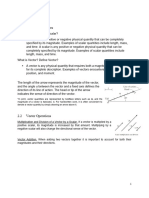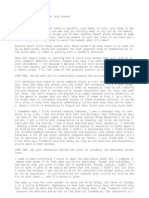Polygon Law of Forces
Polygon Law of Forces
Uploaded by
NitinCopyright:
Available Formats
Polygon Law of Forces
Polygon Law of Forces
Uploaded by
NitinCopyright
Available Formats
Share this document
Did you find this document useful?
Is this content inappropriate?
Copyright:
Available Formats
Polygon Law of Forces
Polygon Law of Forces
Uploaded by
NitinCopyright:
Available Formats
Parallelogram Law of Vectors
The parallelogram law of vectors enables us to determine the single vector called resultant vector
which can replace the two vectors acting at a point with the same effect as that of the two vectors.
This law was formulated based on exprimental results on a body subjected to two forces. This law
can be applied not only to the forces but to any two vectors like velocities, acceleration, momentum
etc. Though stevinces employed it in 1586, the credit of presenting it as a law goes to Varignon
and Newton (1687). This law states that if two forcer (vectors) acting simultaneously on a body
at a point are represented in magnitude and directions by the two adjacent sides of a parallelogram,
their resultant is represented in magnitude and direction by the diagonal of the parallelogram which
passes thorough the point of intersection of the two sides representing the forces (vectors).
In the Fig. 1.3, the force F1 = 4 units and the force F2 = 3 unit are acting on a body at a
point A. To get the resultant of these forces, according to this law, construct the parallelogram
ABCD such that AB is equal to 4 units to the linear scale and AC is equal to 3 units. Then according
to this law, the diagonal AD represents the resultant in magnitude and direction. Thus the resultant
of the forces F1 and F2 is equal to the units corresponding to AD in the direction to F1.
Polygon Law of Forces (Vectors)
If more than two forces (vectors) are acting on a body, two forces (vectors) at a line can be
combined by the triangle law, and finally resultant of all forces (vectors) acting on the body may
be obtained.
A system of four concurrent forces acting on a body are shown in Fig. 1.4. AB represents F1
and BC represent F2. Hence according to triangle law of forces AC represents the resultant of F1
and F2, say R1.
If CD is drawn to represent F3, then from the triangle law of forces AD represents the resultant
of R1 and F3. In other words, AD represents the resultant of F1, F2 and F3. Let it be called as R2.
Similarly the logic can be extended to conclude that AE represents the resultant of F1, F2, F3
and F4. The resultant R is represented by the closing line of the polygon ABCDE in the direction
form A to E. Thus we have derived the polygon law of the forces (vectors) and it may be stated
as if a number of concurrent forces (vectors) acting simultaneously on a body are represented in
magnitude and direction by the sides of a polygon, taken in a order, then the resultant is represented
in magnitude and direction by the closing side of the polygon, taken from the first point to the last
point
Analytical Method of Composition of Two Vectors
Parallelogram law, triangle law and polygonal law of vectors can be used to find the resultant
graphically. This method gives a clear picture of the work being carried out. However the main
disadvantage is that it needs drawing aids like pencil, scale, drawing sheets. Hence there is need for
analytical method.
You might also like
- Kama SutraDocument96 pagesKama SutraAnderson London100% (1)
- Resultant of Coplanar ForcesDocument18 pagesResultant of Coplanar Forcesapi-24848312486% (7)
- Motion To Discharge of An Accused To Be A State WitnessDocument3 pagesMotion To Discharge of An Accused To Be A State WitnessKM Mac100% (2)
- Physics Lab Report 2.0 Resultant and Equilibrant ForcesDocument3 pagesPhysics Lab Report 2.0 Resultant and Equilibrant ForcesIan Garcia0% (1)
- Soap NotesDocument4 pagesSoap NotesLatora Gardner Boswell100% (3)
- L-1 Introduction To MechanicsDocument10 pagesL-1 Introduction To Mechanicspinku kumarNo ratings yet
- FME Unit1.1 24-25Document12 pagesFME Unit1.1 24-25Aman SharmaNo ratings yet
- Arc 206 - Notes - 2024 - 075255Document32 pagesArc 206 - Notes - 2024 - 075255xhk25bzxzkNo ratings yet
- LN 10, 11 & 12 - ME 1227 Engineering MechanicsDocument33 pagesLN 10, 11 & 12 - ME 1227 Engineering MechanicsSakibNo ratings yet
- EET 212 2018 2019 Note A-1Document32 pagesEET 212 2018 2019 Note A-1abdulwasih29No ratings yet
- Fundamental of Mechanics 2nd Year 1st SemesterDocument429 pagesFundamental of Mechanics 2nd Year 1st Semestersiamanwar893No ratings yet
- Force System and EquilibriumDocument25 pagesForce System and EquilibriumAnisha GhoshNo ratings yet
- 6-Moments Couples and Force Couple Systems - PartbDocument37 pages6-Moments Couples and Force Couple Systems - PartbLevi PogiNo ratings yet
- Concurrent Forces and Coplanar Forces - EngineersfieldDocument9 pagesConcurrent Forces and Coplanar Forces - EngineersfieldHoluwa DijexNo ratings yet
- 6-Moments Couples and Force Couple Systems - PartbDocument39 pages6-Moments Couples and Force Couple Systems - PartbsaishvNo ratings yet
- 2nd LecDocument5 pages2nd LecSalman KhanNo ratings yet
- CHAPTER 3 Angular Impulse and Angular MomentumDocument6 pagesCHAPTER 3 Angular Impulse and Angular MomentumYilikal passNo ratings yet
- Resultant of Non - Concurrent Force SystemsDocument10 pagesResultant of Non - Concurrent Force SystemsKRISTELLE GEM CABANIGNo ratings yet
- Free Body Diagram: Sme1101 Engineering Mechanics Course Material (Unit 2) 2015 RegulationsDocument19 pagesFree Body Diagram: Sme1101 Engineering Mechanics Course Material (Unit 2) 2015 RegulationsWaled HantashNo ratings yet
- Week 2 NotesDocument15 pagesWeek 2 NotesRuai Lok Riek YangNo ratings yet
- 5 2020 02 13!12 40 35 AmDocument10 pages5 2020 02 13!12 40 35 AmRaafa AliankaNo ratings yet
- FME Notes Unit1-1Document13 pagesFME Notes Unit1-1vishal shuklaNo ratings yet
- CHP 2 - Force SystemDocument15 pagesCHP 2 - Force SystemSagheer AhmedNo ratings yet
- Non-Coplanar: Unit 1 Coplanar and ForcesDocument28 pagesNon-Coplanar: Unit 1 Coplanar and ForcesSandhu GuriqbalNo ratings yet
- EM&SOM With AnswersDocument24 pagesEM&SOM With AnswersMohith SNo ratings yet
- Lecture 1Document8 pagesLecture 1Anas MohamedNo ratings yet
- Exp (2) - Vectors (Lab Report)Document12 pagesExp (2) - Vectors (Lab Report)Mansoor Al TunijiNo ratings yet
- Mee 203 - 20232024 - 3Document15 pagesMee 203 - 20232024 - 3kunleade2255No ratings yet
- 6-Moments Couples and Force Couple SystemsDocument69 pages6-Moments Couples and Force Couple SystemsJamal JalalaniNo ratings yet
- Components of A Force in XY PlaneDocument22 pagesComponents of A Force in XY PlaneRomalyn GalinganNo ratings yet
- Coplanar ForcesDocument3 pagesCoplanar ForcesJanaka Priyalal100% (1)
- Law of PolygonDocument7 pagesLaw of Polygonuser10150% (10)
- EM&SOMwith Out AnswersDocument7 pagesEM&SOMwith Out AnswersMohith SNo ratings yet
- Force System and ResultantDocument20 pagesForce System and ResultantMyra GarciaNo ratings yet
- Lecture 8 - Couples Changing The Line of Action of A Force (Equivalent Force-Couple System) PDFDocument48 pagesLecture 8 - Couples Changing The Line of Action of A Force (Equivalent Force-Couple System) PDFMichael Jeawel AlabanNo ratings yet
- System of Coplanar ForcesDocument18 pagesSystem of Coplanar Forceschandan_j4u100% (1)
- ch4 p70 92Document23 pagesch4 p70 92GOONo ratings yet
- MECH 211 - Couples, Moment of ForceDocument28 pagesMECH 211 - Couples, Moment of ForceJohn David AbarquezNo ratings yet
- 7 Force AnalysisDocument19 pages7 Force AnalysisEn Eskay50% (2)
- Chapter 2Document59 pagesChapter 2Raghed AlsnaidNo ratings yet
- Lecture 4 Rigid BodiesDocument75 pagesLecture 4 Rigid Bodiessysybituin27No ratings yet
- A (Bold Faced) : by HandDocument79 pagesA (Bold Faced) : by Handএ. এইচ ফিরোজNo ratings yet
- Resolution of A ForceDocument11 pagesResolution of A ForceAleksandra FerrabyNo ratings yet
- 4 Traction and StressDocument16 pages4 Traction and Stressmuna222No ratings yet
- Topic 2. Force VectorDocument18 pagesTopic 2. Force VectorArnold Apostol Jr.No ratings yet
- Basic MechanicsDocument22 pagesBasic MechanicsBin MassoudNo ratings yet
- AQA Physics BladDocument10 pagesAQA Physics Bladwill bellNo ratings yet
- Unit 1 - 2nd PPT (Parallelogram Law of Forces, Moment, Couple and Problems)Document14 pagesUnit 1 - 2nd PPT (Parallelogram Law of Forces, Moment, Couple and Problems)Juhi ShekokarNo ratings yet
- Couple and Moment NumericalsDocument2 pagesCouple and Moment NumericalsManpreet Litt100% (1)
- Ge8292: Engineering MechanicsDocument13 pagesGe8292: Engineering MechanicsPradeep KumarNo ratings yet
- Chapter 3Document12 pagesChapter 3Bruce RiversNo ratings yet
- Chapter2-Resultants of Force SystemsDocument28 pagesChapter2-Resultants of Force SystemsIana LeynoNo ratings yet
- Adding Forces Resultant and Equilibrium, Resolving Forces ComponentDocument18 pagesAdding Forces Resultant and Equilibrium, Resolving Forces ComponentHisyamAl-MuhammadiNo ratings yet
- ME1 Concurrent Forces and Static Equilibrium: ObjectivesDocument5 pagesME1 Concurrent Forces and Static Equilibrium: ObjectivesAhmed AbuNasserNo ratings yet
- 1 - Scalars, Vectors, Truss AnalysisDocument7 pages1 - Scalars, Vectors, Truss AnalysisShiestyTNo ratings yet
- Chapter 2 Forces and EquilibriumDocument53 pagesChapter 2 Forces and EquilibriumvinoNo ratings yet
- GE 8292 Two MarksDocument8 pagesGE 8292 Two Markspavithradarsini20051001No ratings yet
- Statics and TranslationsDocument20 pagesStatics and TranslationsDanielNo ratings yet
- Mechanics NotesDocument86 pagesMechanics Notesrajeshshinde813No ratings yet
- Tae 102-SM01Document49 pagesTae 102-SM01AnonymusNo ratings yet
- Hardox400 DataDocument6 pagesHardox400 DataNitinNo ratings yet
- TitaniumDocument7 pagesTitaniumNitinNo ratings yet
- Nozzle Loads - Part 1 - Piping Engineering - Knowledge BaseDocument6 pagesNozzle Loads - Part 1 - Piping Engineering - Knowledge BaseNitinNo ratings yet
- Motion - Control2 - J ScrewDocument3 pagesMotion - Control2 - J ScrewNitinNo ratings yet
- ASTM Designation SystemDocument1 pageASTM Designation SystemNitinNo ratings yet
- Weld Joint Design Equations and CalculationsDocument37 pagesWeld Joint Design Equations and CalculationsNitin100% (1)
- Canadian Standards AssociationDocument1 pageCanadian Standards AssociationNitinNo ratings yet
- World Steel StandardsDocument1 pageWorld Steel StandardsNitinNo ratings yet
- Introduction To EuropeanDocument1 pageIntroduction To EuropeanNitinNo ratings yet
- Astm A 941Document1 pageAstm A 941NitinNo ratings yet
- Differential Screw JackDocument1 pageDifferential Screw JackNitinNo ratings yet
- Perfect, Deficient and Redundant TrussesDocument1 pagePerfect, Deficient and Redundant TrussesNitinNo ratings yet
- Lesson 1 - Basic I EnglishDocument10 pagesLesson 1 - Basic I EnglishVictor QuintanillaNo ratings yet
- Electron Config Dorm LPDocument3 pagesElectron Config Dorm LPJoric MagusaraNo ratings yet
- 44A Villegas V HIU CHIONG TSAI PAO HO PDFDocument3 pages44A Villegas V HIU CHIONG TSAI PAO HO PDFKJPL_1987No ratings yet
- Writing Love SceneDocument10 pagesWriting Love SceneJose Dominic TolentinoNo ratings yet
- The Right To A Balanced and Healthful Ecology by Antonio G.M. La ViñaDocument30 pagesThe Right To A Balanced and Healthful Ecology by Antonio G.M. La Viñaellen joy chanNo ratings yet
- 7 - Ideation and PrototypingDocument44 pages7 - Ideation and PrototypingHasnain AhmadNo ratings yet
- Titanic PDFDocument13 pagesTitanic PDFAnonymous SofmZSNo ratings yet
- LABORATORY EXERCISE The Gastrointestinal System With Accessory GlandDocument5 pagesLABORATORY EXERCISE The Gastrointestinal System With Accessory GlandGelo AlonzoNo ratings yet
- Dias WLP W2Document5 pagesDias WLP W2John Lester CubileNo ratings yet
- 2 - Divine Creation and The First Humankind SinningDocument10 pages2 - Divine Creation and The First Humankind SinningBible_lover_BillNo ratings yet
- Irma Villarreal ResumeDocument5 pagesIrma Villarreal ResumeMichelle JohnsonNo ratings yet
- 16 Tenses (Definition, Usage, Example, Exercises)Document16 pages16 Tenses (Definition, Usage, Example, Exercises)FajarZainNo ratings yet
- Eng HLP1Document11 pagesEng HLP1Tasneem32No ratings yet
- Caraveo 2007Document8 pagesCaraveo 2007Karla SuárezNo ratings yet
- Contact AnalysisDocument39 pagesContact AnalysisJay SrivastavaNo ratings yet
- Thesis Statement Shakespeare Sonnet 130Document7 pagesThesis Statement Shakespeare Sonnet 130jenniferslatteryranchocucamonga100% (1)
- Jeab 1 PsDocument20 pagesJeab 1 PsDharmveer KumarNo ratings yet
- Senior Assistant 5th Level AdministrationDocument9 pagesSenior Assistant 5th Level AdministrationArjun kumar ShresthaNo ratings yet
- Can 065 December 2012Document24 pagesCan 065 December 2012sthelenscenNo ratings yet
- Daftar Input Nama CoverDocument240 pagesDaftar Input Nama CoverMuhammad IsepNo ratings yet
- 01204427-Modes of OperationDocument38 pages01204427-Modes of OperationSwati SharmaNo ratings yet
- Discrete Probability Distributions: Mcgraw-Hill/IrwinDocument15 pagesDiscrete Probability Distributions: Mcgraw-Hill/IrwinImam AwaluddinNo ratings yet
- Film Studies Assignment 1 BriefDocument3 pagesFilm Studies Assignment 1 Briefapi-267656373No ratings yet
- PDQ Session 1Document4 pagesPDQ Session 1api-403189689No ratings yet
- HUMANBEH Chapter 12 Informal and Formal GroupsDocument19 pagesHUMANBEH Chapter 12 Informal and Formal GroupsEugene AguirreNo ratings yet
- The Narrative Study of Self and SocietyDocument18 pagesThe Narrative Study of Self and Society吴善统No ratings yet
- Proc No.685 - 2010 Trade Practice and Consumers ProtectionDocument32 pagesProc No.685 - 2010 Trade Practice and Consumers ProtectionEskedar EthiopiaNo ratings yet





































































































